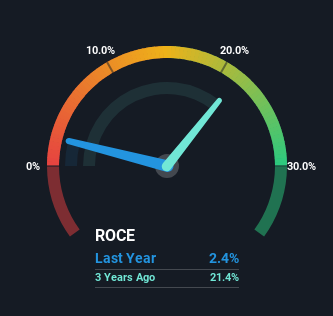- United States
- /
- Tech Hardware
- /
- NasdaqGS:STX
Returns On Capital Signal Difficult Times Ahead For Seagate Technology Holdings (NASDAQ:STX)

Ignoring the stock price of a company, what are the underlying trends that tell us a business is past the growth phase? More often than not, we'll see a declining return on capital employed (ROCE) and a declining amount of capital employed. Ultimately this means that the company is earning less per dollar invested and on top of that, it's shrinking its base of capital employed. So after we looked into Seagate Technology Holdings (NASDAQ:STX), the trends above didn't look too great.
Return On Capital Employed (ROCE): What Is It?
Just to clarify if you're unsure, ROCE is a metric for evaluating how much pre-tax income (in percentage terms) a company earns on the capital invested in its business. The formula for this calculation on Seagate Technology Holdings is:
Return on Capital Employed = Earnings Before Interest and Tax (EBIT) ÷ (Total Assets - Current Liabilities)
0.024 = US$103m ÷ (US$8.0b - US$3.6b) (Based on the trailing twelve months to March 2023).
Thus, Seagate Technology Holdings has an ROCE of 2.4%. In absolute terms, that's a low return and it also under-performs the Tech industry average of 7.2%.
See our latest analysis for Seagate Technology Holdings

Above you can see how the current ROCE for Seagate Technology Holdings compares to its prior returns on capital, but there's only so much you can tell from the past. If you'd like, you can check out the forecasts from the analysts covering Seagate Technology Holdings here for free.
What Can We Tell From Seagate Technology Holdings' ROCE Trend?
The trend of ROCE at Seagate Technology Holdings is showing some signs of weakness. To be more specific, today's ROCE was 25% five years ago but has since fallen to 2.4%. In addition to that, Seagate Technology Holdings is now employing 27% less capital than it was five years ago. The combination of lower ROCE and less capital employed can indicate that a business is likely to be facing some competitive headwinds or seeing an erosion to its moat. If these underlying trends continue, we wouldn't be too optimistic going forward.
On a side note, Seagate Technology Holdings' current liabilities have increased over the last five years to 46% of total assets, effectively distorting the ROCE to some degree. Without this increase, it's likely that ROCE would be even lower than 2.4%. And with current liabilities at these levels, suppliers or short-term creditors are effectively funding a large part of the business, which can introduce some risks.
Our Take On Seagate Technology Holdings' ROCE
In short, lower returns and decreasing amounts capital employed in the business doesn't fill us with confidence. Despite the concerning underlying trends, the stock has actually gained 32% over the last five years, so it might be that the investors are expecting the trends to reverse. Either way, we aren't huge fans of the current trends and so with that we think you might find better investments elsewhere.
One more thing to note, we've identified 3 warning signs with Seagate Technology Holdings and understanding them should be part of your investment process.
For those who like to invest in solid companies, check out this free list of companies with solid balance sheets and high returns on equity.
New: Manage All Your Stock Portfolios in One Place
We've created the ultimate portfolio companion for stock investors, and it's free.
• Connect an unlimited number of Portfolios and see your total in one currency
• Be alerted to new Warning Signs or Risks via email or mobile
• Track the Fair Value of your stocks
Have feedback on this article? Concerned about the content? Get in touch with us directly. Alternatively, email editorial-team (at) simplywallst.com.
This article by Simply Wall St is general in nature. We provide commentary based on historical data and analyst forecasts only using an unbiased methodology and our articles are not intended to be financial advice. It does not constitute a recommendation to buy or sell any stock, and does not take account of your objectives, or your financial situation. We aim to bring you long-term focused analysis driven by fundamental data. Note that our analysis may not factor in the latest price-sensitive company announcements or qualitative material. Simply Wall St has no position in any stocks mentioned.
About NasdaqGS:STX
Seagate Technology Holdings
Engages in the provision of data storage technology and infrastructure solutions in Singapore, the United States, the Netherlands, and internationally.
Moderate average dividend payer.


